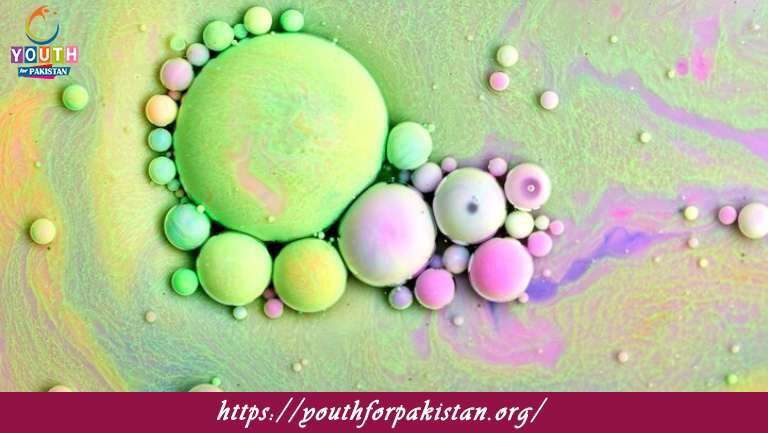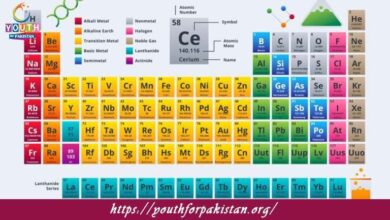12th Class Chemistry Chapter 14 MCQs with Answers

Learn about Macromolecules with 12th Class Chemistry Chapter 14 MCQs. Cover polymers, proteins, and carbohydrates with trending keywords like macromolecule quiz, polymer chemistry MCQs, and biochemistry tests to boost understanding.
12th Class Chemistry
Chapter 14
Which of the following is a macromolecule?
a) Glucose
b) Water
c) Oxygen
d) Carbon dioxide
Macromolecules are large molecules that are composed of:
a) Single atoms
b) Two or more atoms
c) Repeating subunits
d) Non-repeating subunits
The repeating subunits in macromolecules are called:
a) Atoms
b) Molecules
c) Monomers
d) Polymers
Which of the following macromolecules is composed of nucleotides?
a) Proteins
b) Carbohydrates
c) Lipids
d) Nucleic acids
Which of the following macromolecules is composed of amino acids?
a) Proteins
b) Carbohydrates
c) Lipids
d) Nucleic acids
Which of the following macromolecules is composed of simple sugars?
a) Proteins
b) Carbohydrates
c) Lipids
d) Nucleic acids
Which of the following macromolecules is composed of fatty acids and glycerol?
1
a) Proteins
b) Carbohydrates
c) Lipids
d) Nucleic acids
Which of the following macromolecules is responsible for storing genetic information?
a) Proteins
b) Carbohydrates
c) Lipids
d) Nucleic acids
The process by which monomers are linked together to form macromolecules is called:
a) Hydrolysis
b) Dehydration synthesis
c) Denaturation
d) Diffusion
Which of the following reactions is involved in the formation of macromolecules from monomers?
a) Hydrolysis
b) Dehydration synthesis
c) Denaturation
d) Diffusion
The reverse process of dehydration synthesis, where macromolecules are broken down into monomers, is called:
a) Hydrolysis
b) Dehydration synthesis
c) Denaturation
d) Diffusion
Carbohydrates are classified into which of the following groups based on the number of sugar units?
a) Monosaccharides, disaccharides, and polysaccharides
b) Proteins, lipids, and nucleic acids
c) Monomers, polymers, and oligomers
d) Glucose, fructose, and sucrose
Which of the following is an example of a monosaccharide?
a) Glucose
b) Sucrose
c) Starch
d) Cellulose
The monomer unit of carbohydrates is called a:
a) Nucleotide
b) Amino acid
c) Monosaccharide
d) Fatty acid
Which of the following is an example of a disaccharide?
a) Glucose
b) Sucrose
c) Starch
d) Cellulose
The disaccharide sucrose is composed of which two monosaccharides?
a) Glucose and fructose
b) Glucose and galactose
c) Glucose and maltose
d) Glucose and lactose
Starch and glycogen are examples of:
a) Monosaccharides
b) Disaccharides
c) Polysaccharides
d) Oligosaccharides
Which of the following is the storage polysaccharide in plants?
a) Starch
b) Glycogen
c) Cellulose
d) Chitin
Which of the following is the storage polysaccharide in animals?
a) Starch
b) Glycogen
c) Cellulose
d) Chitin
Cellulose is an example of a:
a) Monosaccharide
b) Disaccharide
c) Polysaccharide
d) Oligosaccharide
Which of the following is the structural polysaccharide found in the cell walls of plants?
a) Starch
b) Glycogen
c) Cellulose
d) Chitin
Chitin is an example of a:
a) Monosaccharide
b) Disaccharide
c) Polysaccharide
d) Oligosaccharide
Chitin is a structural polysaccharide found in the exoskeleton of which organisms?
a) Plants
b) Insects and crustaceans
c) Fish
d) Mammals
Proteins are composed of which of the following monomer units?
a) Nucleotides
b) Amino acids
c) Monosaccharides
d) Fatty acids
The monomer units of proteins are linked together by:
a) Hydrolysis
b) Dehydration synthesis
c) Denaturation
d) Diffusion
How many different amino acids are commonly found in proteins?
a) 5
b) 10
c) 20
d) 50
The sequence of amino acids in a protein is called its:
a) Primary structure
b) Secondary structure
c) Tertiary structure
d) Quaternary structure
The folding or coiling of the polypeptide chain into an alpha helix or beta pleated sheet is
referred to as the protein’s:
a) Primary structure
b) Secondary structure
c) Tertiary structure
d) Quaternary structure
The three-dimensional arrangement of the polypeptide chain, including interactions
between distant amino acid residues, is called the protein’s:
a) Primary structure
b) Secondary structure
c) Tertiary structure
d) Quaternary structure
Proteins can undergo denaturation, which is a process that involves:
a) Hydrolysis of peptide bonds
b) Breaking of hydrogen bonds and disulfide bridges
c) Formation of new peptide bonds
d) Formation of new hydrogen bonds and disulfide bridges
Denaturation of a protein leads to the loss of its:
a) Primary structure
b) Secondary structure
c) Tertiary structure
d) Quaternary structure
Lipids are composed of which of the following monomer units?
a) Nucleotides
b) Amino acids
c) Monosaccharides
d) Fatty acids
Fatty acids are long hydrocarbon chains with a group at one end.
a) Hydroxyl (OH)
b) Carboxyl (COOH)
c) Amino (NH2)
d) Phosphate (PO4)
Which of the following is a saturated fatty acid?
a) Oleic acid
b) Linoleic acid
c) Stearic acid
d) Arachidonic acid
Which of the following is an unsaturated fatty acid?
a) Oleic acid
b) Palmitic acid
c) Stearic acid
d) Lauric acid
The presence of double bonds in the carbon chain of a fatty acid causes it to be:
a) Saturated
b) Unsaturated
c) Branched
d) Cyclic
Which of the following is a product of the reaction between glycerol and three fatty acids?
a) Triglyceride
b) Phospholipid
c) Steroid
d) Wax
Triglycerides are also known as:
a) Fats
b) Oils
c) Waxes
d) Phospholipids
Which of the following is an example of a triglyceride?
a) Cholesterol
b) Phospholipid
c) Linoleic acid
d) Olive oil
Phospholipids are composed of which of the following components?
a) Nucleotides and glycerol
b) Amino acids and glycerol
c) Monosaccharides and fatty acids
d) Fatty acids, glycerol, and a phosphate group
Which part of a phospholipid is hydrophilic (water-attracting)?
a) Fatty acid tails
b) Glycerol
c) Phosphate group
d) Both the glycerol and phosphate group
Which part of a phospholipid is hydrophobic (water-repelling)?
a) Fatty acid tails
b) Glycerol
c) Phosphate group
d) Both the glycerol and phosphate group
Phospholipids are the main components of:
a) Cell membranes
b) DNA
c) Enzymes
d) Hormones
Steroids are composed of which of the following structures?
a) Nucleotides
b) Amino acids
c) Monosaccharides
d) Four fused carbon rings
Which of the following is an example of a steroid?
a) Cholesterol
b) Phospholipid
c) Linoleic acid
d) Triglyceride
Cholesterol is an important component of:
a) Cell membranes
b) DNA
c) Enzymes
d) Hormones
Nucleic acids are composed of which of the following monomer units?
a) Nucleotides
b) Amino acids
c) Monosaccharides
d) Fatty acids
Each nucleotide in DNA contains a sugar molecule called:
a) Glucose
b) Ribose
c) Deoxyribose
d) Fructose
Each nucleotide in RNA contains a sugar molecule called:
a) Glucose
b) Ribose
c) Deoxyribose
d) Fructose
Which of the following bases is found in DNA but not in RNA?
a) Adenine
b) Cytosine
c) Guanine
d) Thymine
Which of the following bases is found in RNA but not in DNA?
a) Adenine
b) Cytosine
c) Guanine
d) Uracil
The two strands of DNA are held together by:
a) Hydrogen bonds between nitrogenous bases
b) Ionic bonds between phosphate groups
c) Covalent bonds between sugar molecules
d) Van der Waals forces between nucleotides
Which of the following is the complementary base pair for adenine in DNA?
a) Cytosine
b) Guanine
c) Thymine
d) Uracil
Which of the following is the complementary base pair for cytosine in DNA?
a) Adenine
b) Guanine
c) Thymine
d) Uracil
Which of the following is the complementary base pair for guanine in DNA?
a) Adenine
b) Cytosine
c) Thymine
d) Uracil
Which of the following is the complementary base pair for thymine in DNA?
a) Adenine
b) Cytosine
c) Guanine
d) Uracil
Which of the following is the complementary base pair for adenine in RNA?
a) Cytosine
b) Guanine
c) Thymine
d) Uracil
Which of the following is the complementary base pair for cytosine in RNA?
a) Adenine
b) Guanine
c) Thymine
d) Uracil
Which of the following is the complementary base pair for guanine in RNA?
a) Adenine
b) Cytosine
c) Thymine
d) Uracil
Which of the following is the complementary base pair for uracil in RNA?
a) Adenine
b) Cytosine
c) Guanine
d) Thymine
If you are interested to enhance your knowledge regarding Physics, Chemistry, Biology, and Computer please click on the link of each category, you will be redirected to dedicated website for each category.





